Shukhov rotation hyperboloid

Almost 94 years ago, a wide broadcasting began with one of the engineering masterpieces of that time - the radio tower, built in Moscow according to the project of Vladimir Grigorievich Shukhov. A talented engineer, by then already becoming an academician, having built many complex structures throughout the country, Vladimir Grigorievich embodied a wonderful idea in his tower - he carried out a supporting structure in the form of a hyperboloid of rotation. High strength, wind resistance, low cost of production and ease of construction, coupled with the visual lightness and grace of the tower, rightfully made it one of the symbols of engineering and architectural skill. And although Shukhov designed and built many more complex and advanced objects, it was the tower that became his most famous creation.
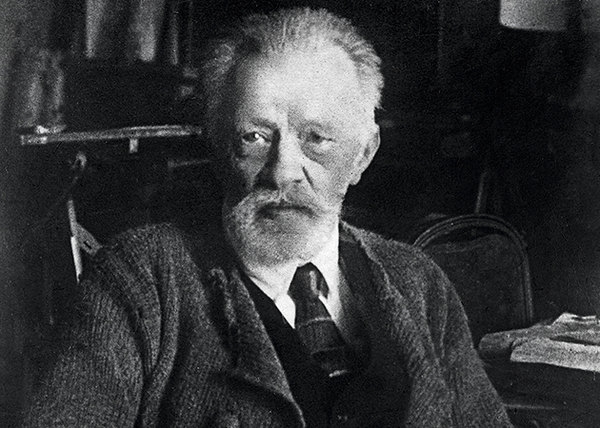
Calling Engineer
The tower on Shabolovka is far from the first hyperboloid construction erected by Vladimir Grigorievich. Back in January 1896, he applied for a patent for the construction of such structures. This brilliant idea in its simplicity and effectiveness was born from his analysis of ... wicker peasant baskets. And for the first time, it was embodied in metal at the Nizhny Novgorod Industrial and Art Exhibition of 1896, where Shukhov built a water tower 25 meters high. The tank contained 10 thousand buckets of water, and on top was an observation deck, where a spiral staircase led.

This water tower has survived to this day. It is a single-cavity hyperboloid of revolution created from 80 straight steel profiled beams. To increase strength, eight steel rings were added to tighten the structure.

It is worth noting that at this exhibition the hyperboloid tower was not the only unique construction of Shukhov. According to his projects in Nizhny Novgorod for the first time in the world erected steel mesh hanging vaults forming exhibition pavilions, including the so-called Shukhov rotunda .


After the exhibition, Shukhov created many openwork metal vaults for a variety of objects. One of the most striking examples is the arches of the Kiev railway station and the GUM in Moscow.




Hyperboloid and hanging mesh constructions were embodied in hundreds of objects: in factories, on water towers, in public buildings. And near Kherson an 80-meter lighthouse was erected.

Shukhov also designed more “traditional” objects - bridges, workshops, cranes, barges, oil refineries, industrial boilers, tanks, pipelines and much more. He paid great attention to the manufacturability of his designs, the convenience of mass production and unification.
The contribution of Vladimir Grigoryevich to the industrialization of the Russian Empire and the Soviet Union is invaluable. With his participation, such giants of industry as Magnitogorsk, Chelyabinsk Tractor Plant, Beloretsky, Vyksunsky, Izhevsky and Nizhny Tagil factories, Azovstal, Caucasian oil pipelines, supplying the country with a strategically important resource, were erected. Over the years, all these enterprises will allow our country to survive in a fierce war.
Tower birth
In 1919, Vladimir Grigorievich Shukhov created a project of a 350-meter hyperboloid radio tower - it was she who was supposed to rise today on Shabolovka.

Eiffel once became famous throughout the world, erecting a 324-meter tower in the center of Paris. But the project of V. Shukhov would overshadow the Frenchman’s design in a number of ways. The creation of the Eiffel Tower required 7.3 thousand tons of metal, and the mass of the hyperboloid tower should have been only 2.2 thousand tons, while it would have been 26 meters higher.
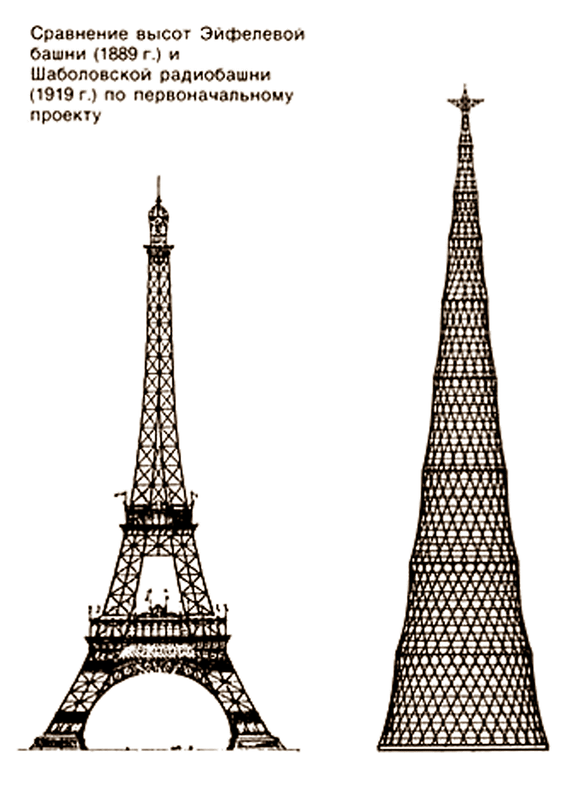
Alas, this unique project has not been implemented. It was 1919, a civil war reigned in the country and devastation.
Metal was in great shortage, and Shukhov was denied the construction of a tower. Then the tireless engineer created a new project - about 150 m high and weighing 240 tons. It was approved by Lenin, construction work began.
Resolution of the Workers 'and Peasants' Defense Council.
- In order to ensure reliable and constant communication between the center of the Republic and Western countries and the outskirts of the Republic, it is entrusted to the People’s Commissariat of Post and Telegraphs to establish, in an extremely urgent manner, in Moscow a radio station equipped with the most advanced devices and machines and with sufficient power to carry out this task.
- All government agencies and organizations are invited to provide the People’s Commissariat of Post and Telegraphs in carrying out this task the most active and vigorous assistance in terms of supplying all necessary materials, transport. road, water and horse-drawn, and to attract qualified and unskilled workers to this work, providing them with food and housing.
- Those who work on the installation of the radio station should be considered mobilized on the spot and therefore not subject to appeal / regardless of age / until the radio station is completed.
- All qualified and non-qualified workers who are installing the radio station should be given out a Red Army ration until the radio station is finished.
- To monitor the implementation of this task as soon as possible and the correctness of the work carried out, establish by order of the Compostor a special commission of employees of the Compostel and representatives from V.S.N.Kh. State control and from the Radio section of the Proletarian Production Union of People’s Communications; members of the commission to establish special remuneration within the limits provided for by the decisions of S.N.K. about part-time.
Chairman of the Council of Defense V. Ulyanov / Lenin /
Kremlin, Moscow,
July 30, 1919
The Shukhov Radio Tower consists of six tiers (each height is 25 m). Each tier is a rotation hyperboloid - a three-dimensional structure of straight steel beams, the ends of which are fastened by steel rings.
The first tier rests on a concrete foundation with a diameter of 40 m and a depth of 3 m. The tower was built without using scaffolding or cranes - each next tier was assembled inside the tower, and with the help of blocks and winches it went up. That is, the tower grew telescopically.

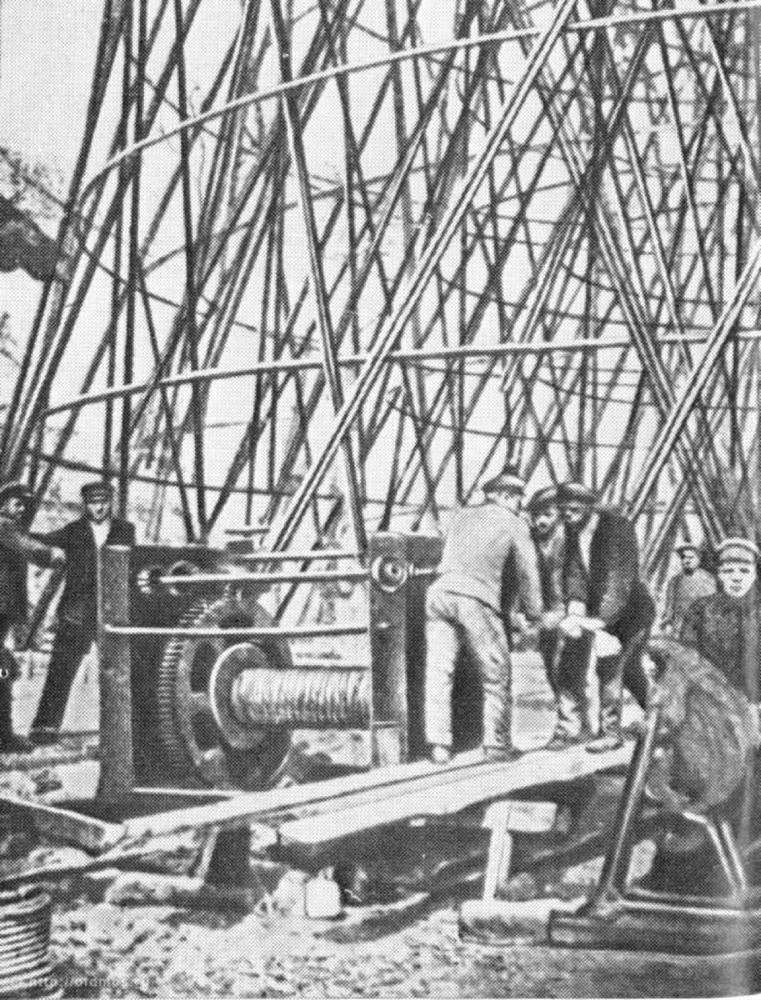
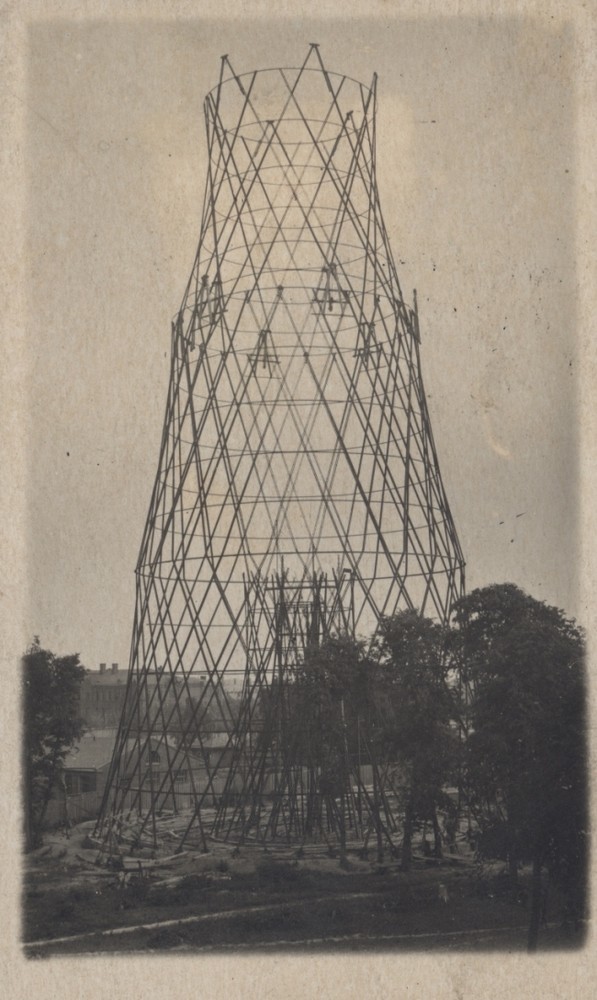
The supply of construction to the metal was carried out by personal order of Lenin, but interruptions still arose. And the quality of the metal was also not always satisfactory. When lifting the fourth tier, the steel cable broke, and the fallen structure damaged the already erected tiers. This incident almost cost the life of Shukhov himself, since the Cheka commission initially regarded this as sabotage.

Fortunately, the true cause of the cliff was confirmed - metal fatigue, so construction was resumed.
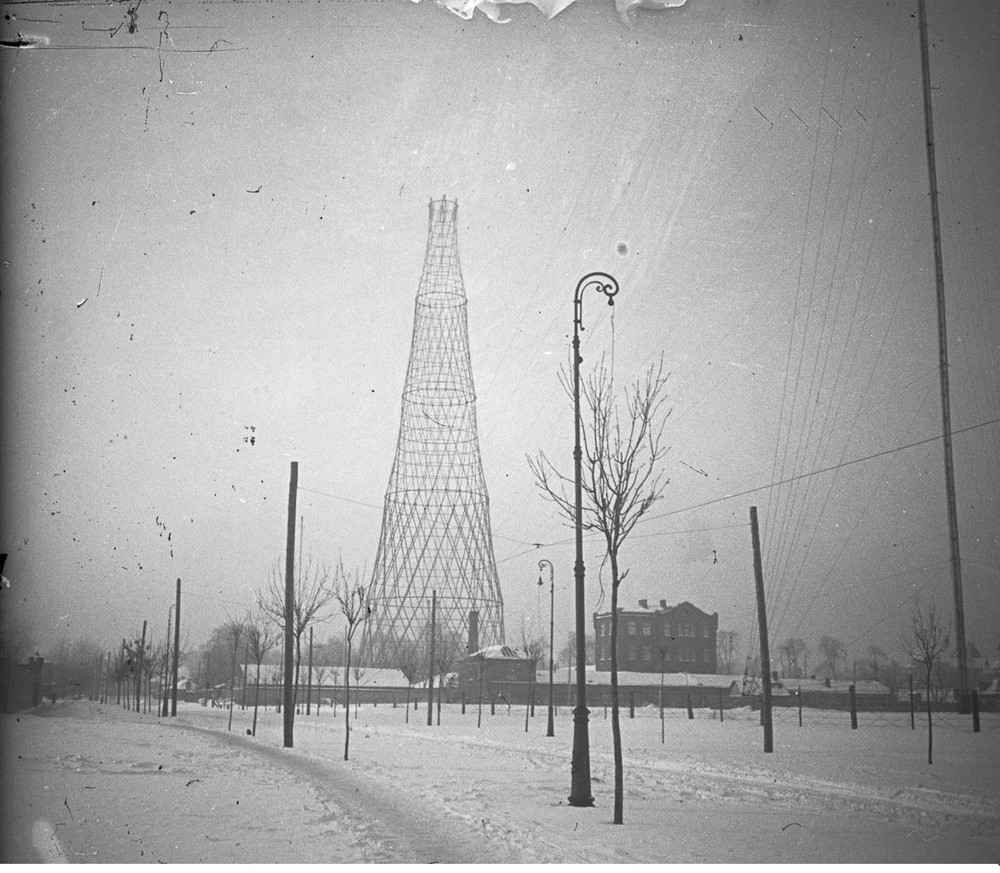
Here is a quote from Shukhov’s workbook dated February 28, 1919, which describes the methodology for calculating the radius of the support rings of each hyperboloid tier:
“The outer contour of the contour of the tower. Main size. Cone with variable r running constant increment; in our case r, 2r, 3r, 4r ... or generally r, r + f, r + 2f, r + 3f, etc. and a variable increment with a continuous increase in the slope from the vertical α. Those. the slope increment is expressed by the formula α * n * (n - 1) / 2, where n is the number of the tower floor, counting from the top. Thus, the following series is obtained: 1) f, 2) 2f + α, 3) 3f + 3α, 4) 4f + 6α, 5) 5f + 10α, 6) 6f + 15α, 7) 7f + 21α, 8) 8f + 28α, etc., and the sizes r, f, and α are specified. In this case, r = 2.75 m, f = 2.75 m = r, α = 0.25 m, and therefore the radii are 2.75, 5.75, 9, 12.5, 16.25, 20.25 (slopes 3 → 3.25 → 3 , 5 → 3.75 → 4). ”
Based on these data, the radius of the support ring of the tier n is expressed by the formula:
R = 2.75 * n + 0.25 * n * (n - 1) / 2.
And since the height of each section is 25 m, the distance from the top of the tower to the support ring of section n is H = 25 * n. Then the above formula can be expressed as follows:
R = H * H / 5000 + H * 21/200
Although it should be noted that the actual dimensions of the support rings coincide with the calculated only in the four lower tiers. That is, Shukhov made changes to the project already at the construction stage. Also, the results of modern measurements show that the nodes of the joining of beams of different tiers completely do not coincide with the drawings of 1919. That is, it can be assumed that after the construction began, Vladimir Grigoryevich continued to improve the design of the tower, making a lot of changes compared to the original project.
In 1922, the construction of the tower was completed, and regular broadcasting began on March 19. In March 1939, the Shukhov Tower became the main source and symbol of television broadcasting in the USSR, retaining this role until the Ostankino TV tower was commissioned.
The brainchild of Shukhov soon became famous throughout the country, and then mesh steel shells began to be widely used throughout the world. Over the past almost 100 years, several high-rise hyperboloid towers have been built in the world , including a 600-meter TV tower in China . By the way, it was the Shukhov Tower that inspired Alexei Tolstoy to write the science fiction novel " Engineer Hyperboloid Garin ."


The hyperboloid design turned out to be very economical in terms of metal consumption, but at the same time quite durable. And its openwork allows you to effectively resist the wind load, the main enemy of high-rise buildings. The structural elements are simple to manufacture, therefore, their cost is low. During construction, the use of complex or labor-intensive technologies is not required, since the joints were made by riveting. The stability of the tower is ensured not only due to the mutual arrangement of the beams that make up the hyperboloids, but also due to a certain proportion of mobility of riveted joints, in contrast to welded or bolted ones.

Although the Shukhov Tower is 2 times lower than the Eiffel Tower, it is still interesting to conduct a superficial comparison of these projects. The metal intensity was already mentioned above: at a comparable height, Shukhov's design requires 3 times less metal. In addition, the tower on Shabolovka is more technologically advanced in terms of the diversity of the nomenclature of parts and connecting nodes.
Here is a copy of the 1919 drawing:
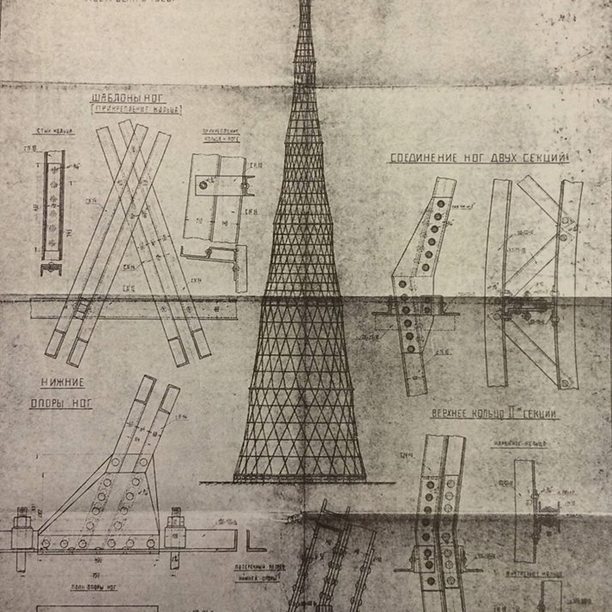
The tower consists of straight beams and ring supports, simple and inexpensive to manufacture. Nodal connections also have a simple configuration. Despite the fact that the actual configurations of the nodes do not coincide with the design, they remain equally simple and technologically advanced.

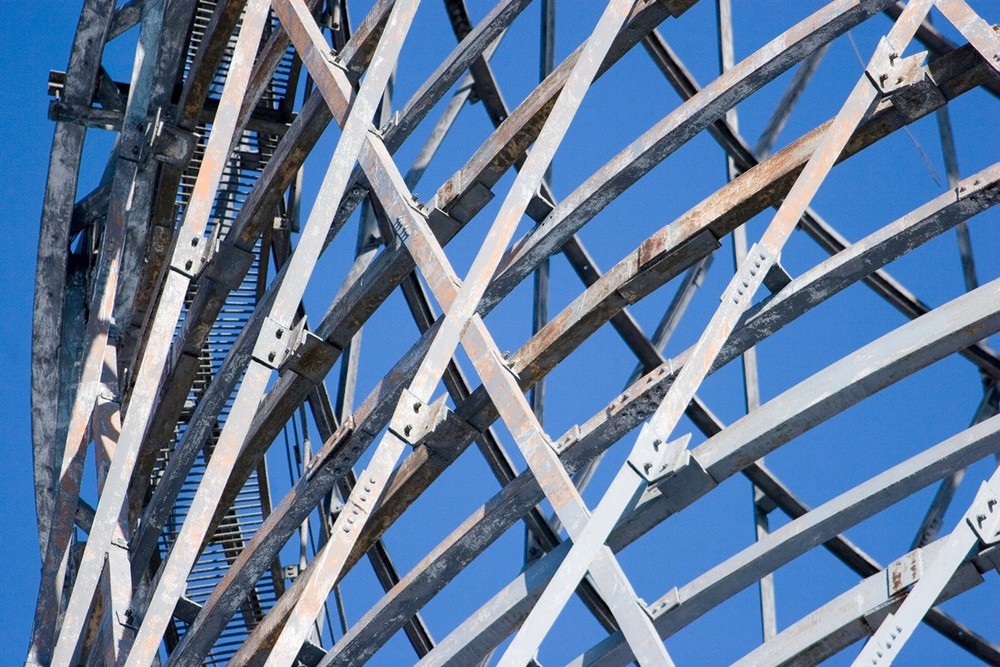
And here are the drawings of the Eiffel Tower, its compounds and some elements:






As the saying goes, feel the difference. Unlike the Parisian "competitor", even the original 350-meter version of the Shukhov Tower would require a much smaller range of parts and would be much cheaper to build.
Some might argue that the Eiffel Tower has higher wind resistance. Indeed, in the entire history of observations, the maximum deviation of the top of the symbol of Paris from the action of the wind reached 12 cm . It is curious that the massive metal structure is much more affected ... by sunlight. On a bright summer day, when the luminary warms up one of the sides of the Eiffel Tower, its top may deviate by 18 cm due to the uneven thermal expansion of the elements.
I must say that at the time the construction of the Shukhov Radio Tower began, the methodology for calculating the strength of hyperboloid structures was far from perfect. In the following decades, it continued to be developed and deepened, but the tower on Shabolovka was built on the basis of calculations characteristic of its time. In particular, simplified models of load distribution were used, and a number of characteristic features were not taken into account, such as twisting of support rings, twisting of beams, and longitudinal deformations. Various empirical and semi-empirical formulas and coefficients were used, and the insufficient accuracy of the calculations was compensated by the laying of excess strength. Nevertheless, studies of the strength of the Shukhov Tower, carried out in the following decades, in which more advanced and accurate calculation methods were used, showed the results,
Two cases speak of the stability of the construction of the Shukhov tower. After its construction, the steel cable connecting the tower with one of the winches on the ground was not dismantled. In the 1930s, a postal plane touched this cable with a wing and fell nearby. The winch tore off the foundation, and the tower received a strong blow. However, inspection of the structure showed that the hyperboloid came out of this mess without any damage or deformation.
The second case is connected with another Shukhov tower - the hyperboloid support of the power transmission line with a height of 128 m, installed on the banks of the Oka. In fact, there were two supports, but one of them in 2005 was destroyed by vandals - for the sake of metal.

A few years later, a third of the beams was cut from the lower tier of the second tower. In this form, the tower stood for several more years, carrying several tons of cables and undergoing pressure from water and ice during floods. Subsequently, the lost structural elements were restored, and the tower still stands. What can we say about the wind stability of the Moscow radio tower.

Unfortunately, in 94 years, the Shukhov Tower on Shabolovka was covered with anticorrosion paint only three times. That is, she spent most of her time without any protection. The steel structure rusted and collapsed, and metal fatigue accumulated. Recently, supporting structures have been installed inside the tower to relieve part of the load. At the same Eiffel Tower, about 3% of elements are replaced annually with similar ones made using the same technologies as during the construction. And the Shukhov Tower has been standing for almost a century without any care. Fortunately, its destruction can be stopped by preserving this unique monument of Russian engineering.
